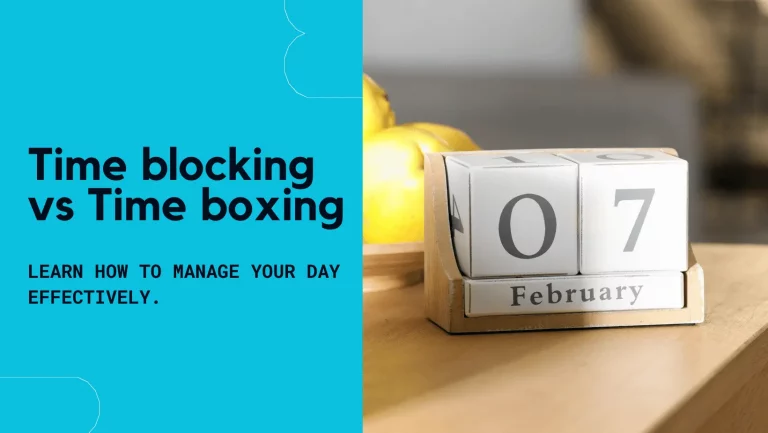Managing time effectively has become more essential in this modern world. Finding the right strategy can make life easier as we navigate the demands of professional and personal tasks. This is where Timeboxing and Time Blocking come in – the two productivity powerhouses that have transformed how many approach their daily lives.
While both Timeboxing and Time Blocking may seem similar, each offers distinct benefits tailored to different needs. In this article, we’ll delve into the intricacies of both techniques, guiding you toward a more efficient and structured tomorrow. Let’s start with the basics:
What Is Time Boxing?
Timeboxing is a time management technique wherein a fixed period or “box” of time is allocated to a particular task. Once the period of the box expires, the task or activity is stopped, even if the task was left incomplete. Timeboxing aims to define a clear start and end point to tasks, which helps promote focus and efficiency and prevent procrastination.
Here are some key features of Time Boxing:
1. Focus and Efficiency: By having a set timeframe, individuals are more likely to concentrate on the task at hand, making the work more efficient.
2. Prevents Perfectionism: If you’re a perfectionist to the point you hate it, then timeboxing may be for you, as knowing that there’s a set end time will discourage endless tweaking and overthinking, which can often result in diminishing returns.
3. Breaks Tasks Into Chunks: By time boxing, you can break longer tasks into small chunks, making the task more manageable.
4. Provides Structure: Several timeboxes throughout the day can create a structured workday, making for great productivity.
5. Feedback Mechanism: At the end of a time box, one can assess their task effectiveness and make more adjustments for future tasks or time boxes.
What Is Time Blocking?
Time Blocking is another time management technique in which specific blocks of time are allocated to a certain task or activity throughout the day or week. People can ensure a designated time and space for everything they need or want to do by assigning specific tasks to specific times.
Here are some key features of Time Blocking:
1. Structured Schedule: Time blocking helps transform a to-do list into a clear, actionable schedule. Instead of knowing you have to do something, you will know exactly when you’ll do it.
2. Prioritization: Time blocking allows you to allocate time for important tasks, ensuring that high-priority items get the attention they deserve.
3. Reduces Multitasking: By dedicating specific blocks of time to one task or activity, the temptation or the need to multi-task reduces, which leads to increased focus on the task at hand.
4. Guards Against Procrastination: When a block of time is set for a task, it creates a commitment to working on it during that period. It mentally prepares you to be ready for the upcoming task, which reduces procrastination.
5. Ensures Personal Time: You can block out times for breaks, hobbies, or relaxation. By doing that, you can avoid burnout and fatigue and be well-rested for the upcoming tasks. Time blocking provides a great work-life balance.
6. Efficient Transitions: By knowing what you’ll be working on in advance, you can mentally prepare yourself and gather the necessary resources for the tasks, which makes transitioning between tasks smoother.
Now that we know the definition of both Timeboxing and Time blocking let’s look at the proven benefits of both time management techniques.
Benefits Of Time Boxing
Timeboxing has many benefits that can improve productivity without the risk of burnout. All of the benefits below have been confirmed to be true and are based on studies regarding time management techniques and psychology.
Enhanced Focus and Task Completion
According to the principle of Parkinson’s Law, work expands to fill the time available for its completion. Time boxing leverages this principle by allocating specific time frames for tasks, which pushes individuals to focus and complete tasks more efficiently.
For example, if you have two weeks to complete a task, it will take you two weeks to complete the task. This is simply because inadequate deadlines make you procrastinate more. By allocating a set time frame to the task, you will get the task done more efficiently.
Reduction in Procrastination
Procrastination can be a major hindrance to productivity. The “Zeigarnik Effect” is a term coined by psychologist Bluma Zeigarnik. It suggests that people remember uncompleted tasks better than completed ones. Through Timeboxing, you can set a clear start and end time, which will nudge people to start their tasks, reducing procrastination.
Mental Well-being and Reduced Burnout
Overworking without breaks often leads to burnout, where people feel exhausted and fatigued. Hence, techniques like the Pomodoro technique recommend short breaks after focused work periods.
The Pomodoro technique uses time boxing, wherein a person works for 25 minutes while focused, taking small five-minute breaks afterward. Enough regular breaks of 5 minutes after 25 minutes of work can lead to better health in general, providing optimal performance.
Improved Task Estimation
Over time, as individuals use time boxing, they get better at estimating how long certain tasks will take, which results in improved future productivity. This aligns with the findings from software development, where iterative processes make teams better at estimating task durations.
Put simply, major work is divided into small tasks, and as people do the small tasks, they will remember just how long that certain task takes on average. They may even find better ways to do the small tasks. This technique is known as Scrum Methodology, often used in the software development field.
Reduction in Time Wasted on Low-Value Tasks
Timeboxing makes individuals more aware of how they are spending their time. A study by Vouchercloud found that the average worker is only productive for about 2 hours and 23 minutes in a standard 8-hour workday.
By allocating specific boxes of time to high-priority tasks, time boxing can help increase this productive time. You can read more about the study by clicking here.
Higher Quality of Work in a Shorter Time
Studies in the realm of Deep Work emphasize the value of uninterrupted, focused work. Timeboxing can foster such deep work periods, which leads to a better quality of work in a shorter duration.
The more focused you are and the fewer distractions that you have, the better your quality of work will be. This is quite self-explanatory. Cal Newport coined the word Deep Work while experimenting with time management techniques.
Benefits Of Time Blocking
Like timeboxing, There are many benefits to using Time Blocking to get tasks done. Similarly, there are many studies and research that prove that Time Blocking can be beneficial in improving productivity and the quality of work.
Structured Day And Reduced Cognitive Load
Time blocking provides a clear roadmap for the day, which reduces the cognitive effort of deciding what to do next. A study published in the journal “Organizational Behavior and Human Decision Processes” found that task-switching or constantly deciding what to tackle next can reduce productivity by as much as 40%.
Improved Work-Life Balance
By allocating specific blocks for both professional tasks and personal activities, individuals can ensure a more balanced life. Research by the American Psychological Association suggests that improved work-life balance can lead to increased job satisfaction and overall well-being.
Protection of Deep Work Periods
Cal Newport, in his book “Deep Work” emphasizes the importance of uninterrupted, focused work sessions. Time blocking is a tool to achieve such sessions, fostering better quality work and innovation.
It should be noted that the quality of the work is better regardless of which time-management method you use. Both Timeboxing and Time blocking are tools to get the most optimal performance out of someone.
Minimized Procrastination
By setting specific times for tasks, time blocking acts as a commitment device, which nudges individuals to start the task, overall reducing the likelihood of procrastination. A study from the “Journal of Consumer Research” indicated that setting specific times for tasks can make individuals up to 2x more likely to engage in them.
Enhanced Prioritization and Decision-Making
Time blocking forces individuals to prioritize tasks based on importance. Research by Columbia Business School indicates that prioritization can enhance decision-making quality and overall productivity.
If you have many tasks, you will want to start with the one that is the most important. Time blocking can help you achieve that with ease, with enhanced productivity and focus without burning out.
Optimized Energy Levels
By blocking tasks in alignment with one’s natural energy rhythms, individuals can optimize performance. The Power of Full Engagement by Jim Loehr and Tony Schwartz emphasizes the importance of aligning tasks with energy levels for optimal productivity.
Put simply, tackling complex tasks during peak energy levels can provide optimal performance and productivity, instead of doing mediocre tasks during peak energy levels.
Increased Accountability
Time blocking provides a visual commitment to tasks. Research in the Journal of Personality and Social Psychology suggests that visual cues can act as strong motivators for task completion, thereby enhancing accountability.
Time Boxing vs Time Blocking
From far away, both timeboxing and time blocking may seem the same, but they’re quite different. Both are tools that help boost your productivity and help you focus more, without you having to go through burnout. Let’s now take a look at the differences between the two.
Duration & Flexibility
- Time boxing involves strictly predetermined periods for specific tasks, pushing for task completion within the “box” of time
- Time blocking focuses on organizing the entire day in blocks, without strict time limits for task completion, but ensuring dedicated time
Approach
- Time boxing creates a sense of urgency and encourages breaking tasks into manageable intervals
- Time blocking enables holistic planning, with a blend of work, breaks, and personal time
Interruptions and Flexibility
- Time boxing typically resists interruptions until the time box is complete
- Time blocking can be more flexible, allowing for adjustments as the day progresses
Applications
Time boxing:
- Ideal for tasks prone to overextension or procrastination
- Used frequently in agile development, like during sprints
- Prominent in techniques like the Pomodoro technique
Time blocking:
- Perfect for professionals with varied daily responsibilities, helping to ensure no task is overlooked
- Useful for balancing meetings, deep work sessions, breaks, and personal activities
- Often employed by leaders and managers to maintain a balanced workday
Challenges
Time boxing:
- Can feel restrictive, especially if the time allocated isn’t sufficient
- May not be suitable for open-ended tasks or deep thinking activities
Time blocking:
- Requires discipline to adhere to the planned blocks
- The risk of over-scheduling or underestimating task durations
When To Use Which?
There are many scenarios where both timeboxing and time blocking can be useful. However, here are the basic scenarios where you can use either of the time management techniques to improve productivity.
- For Defined Tasks: If you’re working on tasks with a clear scope and want to prevent overextension or endless tweaking, timeboxing is your ally.
- For Daily Planning: When you’re looking at the bigger picture, aiming to balance various tasks, meetings, and personal commitments, time blocking is the way to go.
- Combining Both: For optimal results, you can consider merging both techniques. For instance, within a time block dedicated to a task, use timeboxing to manage specific sub-tasks.
How Akiflow Can Help You Be Productive
Both timeboxing and Time blocking are generally done with tools that serve as a visual cue. What if, along with the visual cue, you get notifications regarding your upcoming tasks, meetings, and personal commitments?

Akiflow is a time-management application that is designed to keep your life clean, organized, and productive. It has multi-platform integration, meaning you can see your tasks, calendars, to-dos, and more, in a single place.
Using Akiflow For Time Boxing
- Unified Task Management: Akiflow lets you collect tasks from various sources, like emails, messages, or other to-do apps, and it places them in one unified list. This helps in deciding which tasks to timebox.
- Set Timers: For each task, you can allocate a specific time box within Akiflow. This will help ensure that you stick to the designated time frame for each task.
- Task Prioritization: By assessing the tasks in your unified list, you can decide which ones to tackle first and allocate specific timeboxes accordingly.
- Notifications & Alerts: Akiflow can notify you when your timebox for a particular task is nearing its end, keeping you on track.
Using Akiflow For Time Blocking
- Calendar Integration: Akiflow integrates with calendars, allowing you to visualize your day, week, or month. You can block specific times for tasks, meetings, or personal activities.
- Drag-and-Drop Scheduling: Through Akiflow, you can easily rearrange your tasks and blocks of time with a simple drag-and-drop interface, making timeblocking flexible.
- Task Duration Estimates: For each task in your list, you can estimate how long it might take, aiding in more accurate timeblocking.
- Overlap Alerts: If you’ve inadvertently scheduled two tasks or events at the same time, Akiflow will alert you, ensuring that your time blocks are conflict-free.
- Consolidated View: With a unified view of tasks, notes, and calendar events, you can easily carve out blocks of time for specific activities without the need to switch between multiple apps or platforms.
Conclusion
In essence, while both Time boxing and Time blocking are geared towards elevating productivity, their application can vary based on the nature of the task and individual preferences. Recognising when to deploy each technique or a blend of the two can significantly enhance efficiency and work satisfaction.

How To Manage Time Blindness
Explore five effective tactics to conquer time blindness, a common challenge affecting time perception and management. Learn practical strategies for enhancing productivity and achieving a more organized, time-conscious lifestyle.

Dawn of Success: Crafting Effective Morning Rituals
Explore the transformative power of morning rituals in ‘Dawn of Success., and discover how effective morning routines can boost productivity, enhance well-being, and set the stage for daily achievements

12 Best Google Calendar Alternatives
Explore the top 12 Google Calendar alternatives to boost your productivity and streamline your scheduling. Check the diverse options catering to different needs and find the perfect calendar app for you.

